Valentine Soap with Hearts Recipe
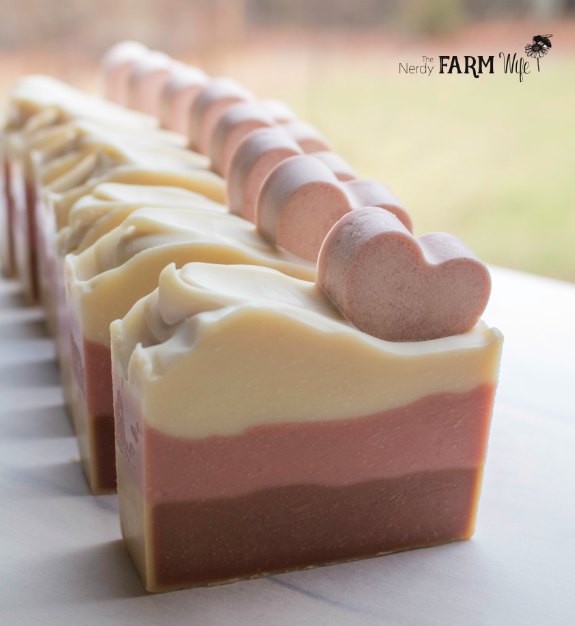
This tricolored soap was dreamed up by newsletter reader Patricia who wanted to make her friends a cute soap for Valentine’s Day.
She requested a soap with three layers – chocolate, vanilla and strawberry, and wanted it to smell like strawberries and chocolate.
While my version doesn’t smell like strawberries since I have family members sensitive to fragrance oils, you could easily add one to the recipe if you’d like.
Instead, I used unrefined cocoa butter for a natural chocolate fragrance and then further enhanced it with some Balsam Peru essential oil to add a hint of vanilla-like scent.
The colors are naturally provided by rose clay, white kaolin clay, non-nano zinc oxide, and cocoa powder, and remind me a lot of the neapolitan ice cream slices my grandma gave me as a kid. :)
It was my husband’s idea to put the pink hearts on top and I think they add the perfect finishing touch.
I love how the soap turned out and will definitely be making it again. (Thanks for the inspiration Patricia!)
Some links on my site are affiliate links. If you click on one and make a purchase, I earn a small commission for sending a customer their way. I only recommend products I’ve personally used and had success with. :)
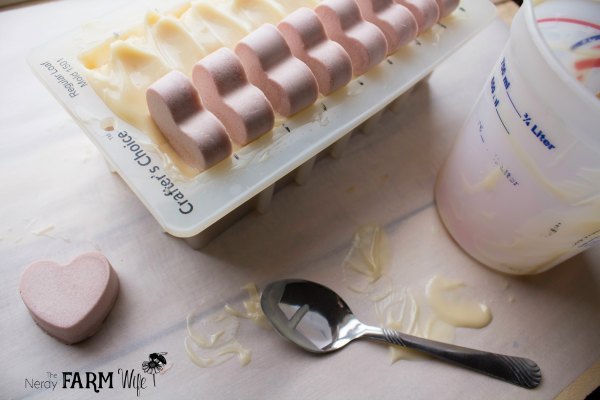
Day One – Make the Small Pink Hearts
I’ve provided two recipe variations. One has tallow in it, while the other is vegan.
Patricia wanted to use moose fat, which I didn’t have available, so used beef tallow instead. Moose tallow can be interchanged for the beef tallow, if you’d like, without the need to change lye amount.
Soap Hearts for Top of Valentine Soap (tallow version)
- 3.3 oz (93.5 g) distilled water (33% water as % of oil weight)
- 1.43 oz (40.5 g) lye (sodium hydroxide) (6% superfat)
- 3.5 oz (99 g) olive oil (35%)
- 3 oz (85 g) coconut oil (30%)
- 2 oz (57 g) tallow (20%)
- 1.5 oz (43 g) cocoa butter (15%)
- 3/4 teaspoon rose clay
- optional: 1/2 teaspoon sodium lactate
Soap Hearts for Top of Valentine Soap (vegan version)
Omit the 2 oz tallow from the recipe above and instead use 1 oz shea butter + an extra 1 oz of olive oil. The lye amount will change very slightly to 1.4 oz (40 g).
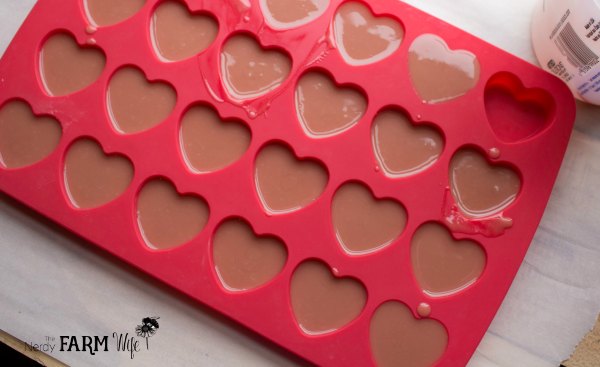
Directions to Make the Soap Hearts
Wearing gloves and goggles, weigh the water into a stainless steel or heatproof plastic container. Weigh the lye and sprinkle into the water. Stir well until the water is no longer cloudy. The temperature will get really hot. Work near an open window, outside or under an exhaust fan. Avoid breathing in the resulting strong fumes that linger for a few moments. Add the rose clay to the lye solution, stir well and set aside in a safe place to cool. Once cooled to around 110 to 120 degrees F, stir in the sodium lactate if using. (It will help the soaps release from the mold much more easily.)
Weigh the tallow, coconut oil and cocoa butter, then heat them in a double boiler or over low heat until melted. While that’s melting, weigh out the olive oil. Add the olive oil to the melted oils and let cool to around 125 degrees F.
Pour the lye solution into the warm oils and mix, alternating hand mixing with a stick blender (like this one) until trace is reached. “Trace” is when your soap batter gets thick enough to leave an imprint or tracing, when you drizzle some of it across the surface.
Pour the soap into a silicone mold with small hearts. I bought this one locally, but it’s almost identical, except for color, as THIS ONE on Amazon. Cover lightly with parchment paper and a light towel or blanket and allow to stay in mold about 24 hours or until they easily release.
Day Two – Make the Valentine Soap
Again, I’ve provided two recipe variations. One has tallow, while the other is vegan.
All measurements are by weight. You must use an accurate scale to make soap.
Valentine Soap with Hearts (tallow version)
- 9.9 oz (281 g) distilled water (33% water as percent of oil weight)
- 4.22 oz (120 g) lye (sodium hydroxide) (6% superfat)
- 9 oz (255 g) olive oil (30%)
- 7.5 oz (213 g) coconut oil (25%)
- 6 oz (170 g) tallow (20%)
- 4.5 oz (128 g) cocoa butter (15%)
- 3 oz (85 g) sweet almond oil (10%) (sunflower could work here too)
- 2 tsp white kaolin clay (to lighten overall color of soap)
- 1/4 tsp zinc oxide + 1 tsp glycerin (for white layer)
- 1 tsp rose clay + 1 tbsp water (for pink layer)
- 3/4 tsp cocoa powder + 1 1/4 tsp glycerin (for cocoa layer)
- 1 oz (28 g) balsam peru essential oil (optional)
- optional: 1 1/2 teaspoon sodium lactate (to help with easier release from mold)
Valentine Soap with Hearts (vegan version)
Omit the 6 oz tallow from the recipe above and instead use 3 oz shea butter + an additional 3 oz of olive oil. Please note that you will need to adjust the amount of lye to 4.15 oz (118 g)
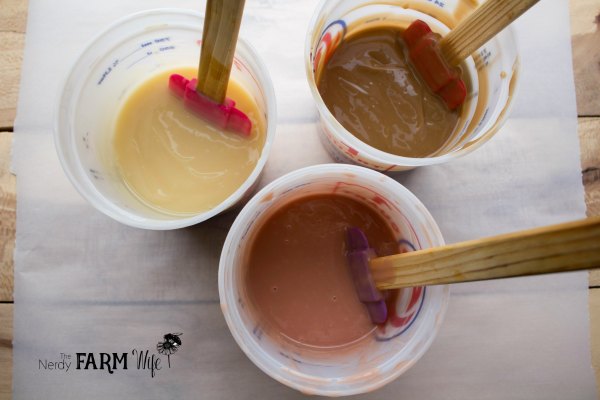
Directions to Make the Soap
Step 1: Make the Lye Solution
Wearing gloves, goggles and long sleeves, weigh the water into a stainless steel or heavy duty plastic (recycle symbol number 5) pitcher. Next, weigh the lye into a small cup or container. Sprinkle the lye into the water and gently stir with a heavy duty plastic or silicone spatula or spoon until the lye is completely dissolved. The temperature will get really hot. Work near an open window, outside or under an exhaust fan. Avoid breathing in the resulting strong fumes that linger for a few moments. (If you have sensitive lungs, breathing problems, or are concerned about the fumes, consider wearing a mask such as THIS ONE.)
Stir in the white kaolin clay to whiten and lighten up the entire batch of soap. This is to help offset the tendency for balsam peru essential oil to slightly discolor soap.
Set the lye solution aside in a safe place where it won’t get disturbed and allow it to cool down around 30 to 40 minutes. Add the sodium lactate if using and stir well.
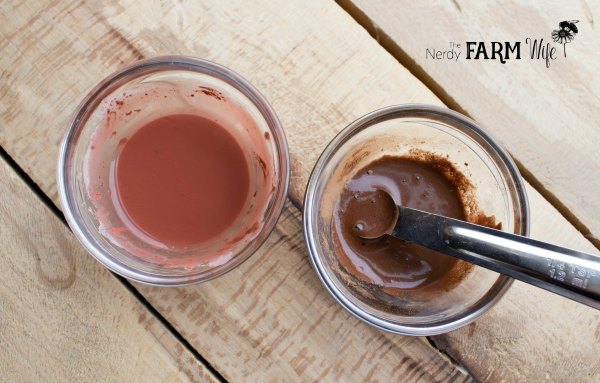
Step 2: Weigh and Heat the Oils; Prepare the Colorants
Weigh out the tallow, cocoa butter and coconut oil and melt them in a double boiler or over low heat until melted. While that melts, weigh out the olive and sweet almond (or sunflower) oils and place them in a heat-resistant soap making pot, bowl or pitcher for mixing.
Pour the hot melted tallow/butter/oil into the other oils. The temperature will be quite warm. Let cool to around 125 degrees F.
While the oils melt, prepare your natural colorants so they’ll be ready when you need them.
Step 3: Combine and Mix Until Trace
If using the balsam peru, you can go ahead and stir it into the oils at this step. Pour the lye solution into the warm oils. Using a stick or immersion blender stir the solution with the motor off for around 30 seconds. Turn the motor on and blend for a minute or so. Stir for another 30 or so seconds with the motor off, then again with the motor on and so forth. Don’t run the stick blender continuously so you don’t risk burning out the motor and/or causing excessive air bubbles in your finished soap.
Alternate with this method until a light trace is reached. “Trace” is when your soap batter gets thick enough to leave an imprint or tracing, when you drizzle some of it across the surface.
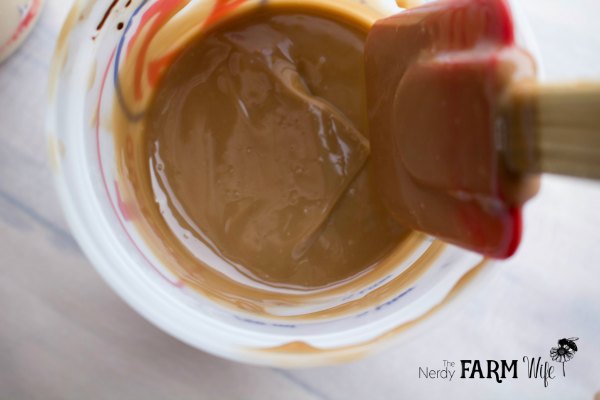
Step 4: Divide the Soap Batter
Divide the soap batter into three containers. Use a scale and aim for around 15 ounces per container.
In the first container, add the zinc oxide/glycerine mixture and blend to a medium trace.
In the second container, add the rose clay and blend to a medium trace.
In the third container, add the cocoa powder/glycerine mixture and blend to a fairly thick trace. It will look a lot like chocolate pudding. (See photo above.)
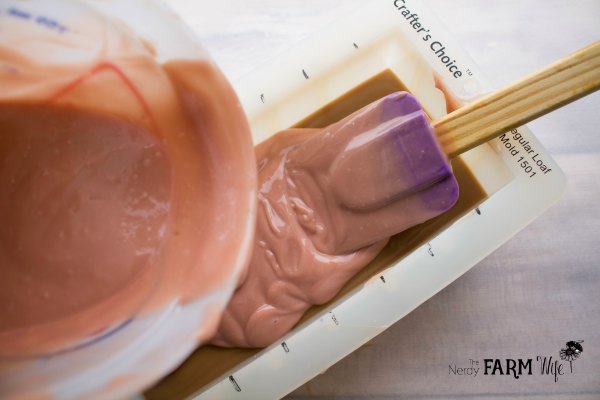
Step 5: Pour Layers into Mold
Scoop the chocolate soap batter into the bottom of the soap mold and smooth with a spatula. Rap the mold firmly on the table a few times to help it settle into place and to remove air bubbles.
Allow the layer to sit undisturbed for about 4 minutes.
Next, carefully pour the pink layer over the chocolate layer. Pour the soap batter over your spatula and keep it down low, so that it doesn’t break through to the bottom layer.
Rap the mold gently on the table a few times, then allow the pink layer to sit undisturbed for about 4 minutes.
Finally, carefully pour on the top white layer, using a spatula to guide the soap batter.
Use a spoon to texturize the top of the soap. You might have to let it sit for 10 or 15 minutes, or until it’s thick enough to hold the design you want.
I used the spoon to push the batter to one side, but you might want to make a peak in the middle or leave it flat. It’s your soap, so be as creative with it as you’d like!
Next, gently press the hearts into the soap batter. I keep lines marked on this soap mold to make sure toppings get spaced evenly and line up with my soap cutter.
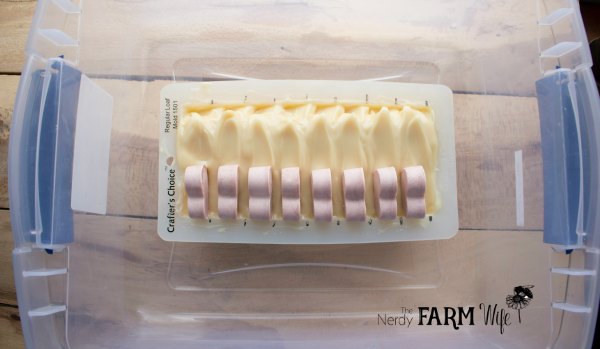
Step 6: Cover the Mold and Wait
I wanted to prevent soap ash without messing up the top of the soap so tucked it down into a plastic box, covered with its lid, then lightly covered with a towel to retain heat and encourage an even gel phase. My house was also really warm from a nearby wood stove.
Leave the soap in the mold and covered for at least 24 hours to reduce the chance of soda ash.
When you can easily pull the sides of the mold away from the soap, it’s ready to be removed.
After unmolding, let the soap stay in the open air for a few hours or overnight if it feels tacky or sticky, then slice into bars when firm.
The bottom layer may have a temporary darker “rind” around it which usually evens out in a day or two.
Let your soap cure for at least 4 weeks, though you can test a small bit on yourself starting at 3 weeks. Generally a longer cure time makes for a milder harder soap that lasts longer.
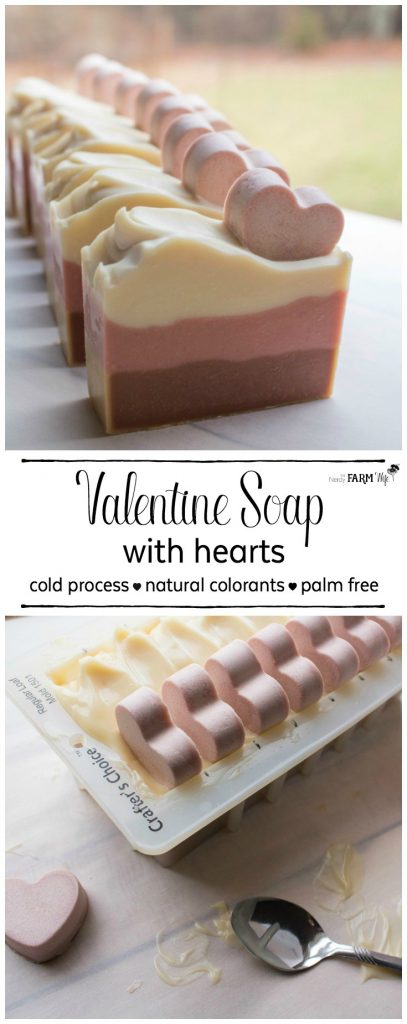

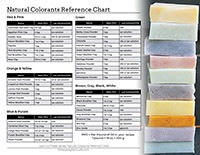

I love your recipes Jan and your ideas. My husband suffers from eczema and I have been looking for something that I could make to help him. Thank you so much!
Hi Lorraine, I’m so happy that you enjoy the recipes & ideas! :)
I love that you use natural colours and fragrances, it is a challenge, but so much better to avoid the synthetic chemicals.
Thank you Liz! I agree, it can be a challenge sometimes, but also lots of fun to experiment with! :)
Thank you for sharing the recipe, just wondering why glycerine to mix cocoa powder and zinc oxode? Will the glycerine make the soap more creamy? Thanks in advance☺️
Hi Dewi! Glycerine helps some colorants (like zinc oxide, cocoa powder, woad, and indigo) mix together more smoothly than if they were mixed with water or oil. In that small amount, it doesn’t usually affect the soap itself though.
However, cocoa powder mixes great with oil too and some forms of zinc oxide will as well. So if you don’t have any glycerine handy, you could save out a little bit of oils from the recipe to use instead. :)
Thank you for giving such great instructions. I am a novice soap maker and my batches don’t always turn out like I would like. The ones I have tried from you do turn out perfectly. I don’t know how to use a lye calculator or adjust the amount of lye if I change an ingredient. Thank you again for such detailed instructions.
Hi Jody, I’m so glad that you enjoy the soap recipes! If you ever need help using a lye calculator or substituting an ingredient in one of my recipes, just let me know & I’m happy to help! :)
Hi, Jan! I love your recipes and your instructions are always so clear and helpful.
I would like to make these soaps for the welcome bags at my upcoming wedding in the Caribbean. To match our wedding colors I wanted to make them turquoise, brown and cream colored, so I was thinking I could replace your colorant with mica colorants from Bramble Berry, but I imagine there’s more to it than I realize in replacing an ingredient. Can you give me some guidance?
For the hearts, I would like to replace the rose clay with aqua pearl mica. And for the bottom, I would like to replace the pink layer (rose clay and water) with the same aqua pearl mica. Is it a simple substitution?
Thank you for your guidance! And for such a fun soap to make!
Cynthia
Hi Cynthia, That sounds like a beautiful soap idea! Bramble Berry show their aqua pearl mica used at 1 teaspoon per pound of cold process soap:
https://www.brambleberry.com/aqua-pearl-mica-p5348.aspx
The rose hearts are about 15 ounces of soap total (lye + water + oils/butter weight) so you could try using about 1 teaspoon for that batch.
For the soap layers – you’ll have about 15 oz of soap per layer, so 1 tsp of aqua pearl mica should be about right for those too.
I’d make a test batch first, just in case you need to adjust colors darker/lighter if you’d like.
Best wishes for a happy and beautiful wedding day! :)
These are just gorgeous, and such a wonderful gift idea! I love your recipes.
Hi Kyla, Thanks! I’m glad you like the recipes! :)
Hi , I made this recipe and substituted the tallow with shea and olive oil like you suggested.
It looks beautiful but I have never had such a soft soap when I unmolded it. Will it harden up over the curing time? Would palm oil instead of tallow have made a harder bar? and would it be a nice moisturising soap with palm oil?
Love your recipes and information you give.
Hi Maria! Yes, it could start off a little softer because of the higher amount of olive oil & the loss of the “hard” oil like tallow (or lard, or palm).
You could certainly use palm in place of the tallow & it should still be nice and moisturizing. Happy soapmaking! :)
Hello, I loved your formula of this soap, a question could you replace zinc oxide with titanium dioxide?
Hi Ruby! Yes, you can use titanium dioxide instead. It’s a stronger white than zinc oxide, so the soap will have a whiter look. Happy soapmaking! ?